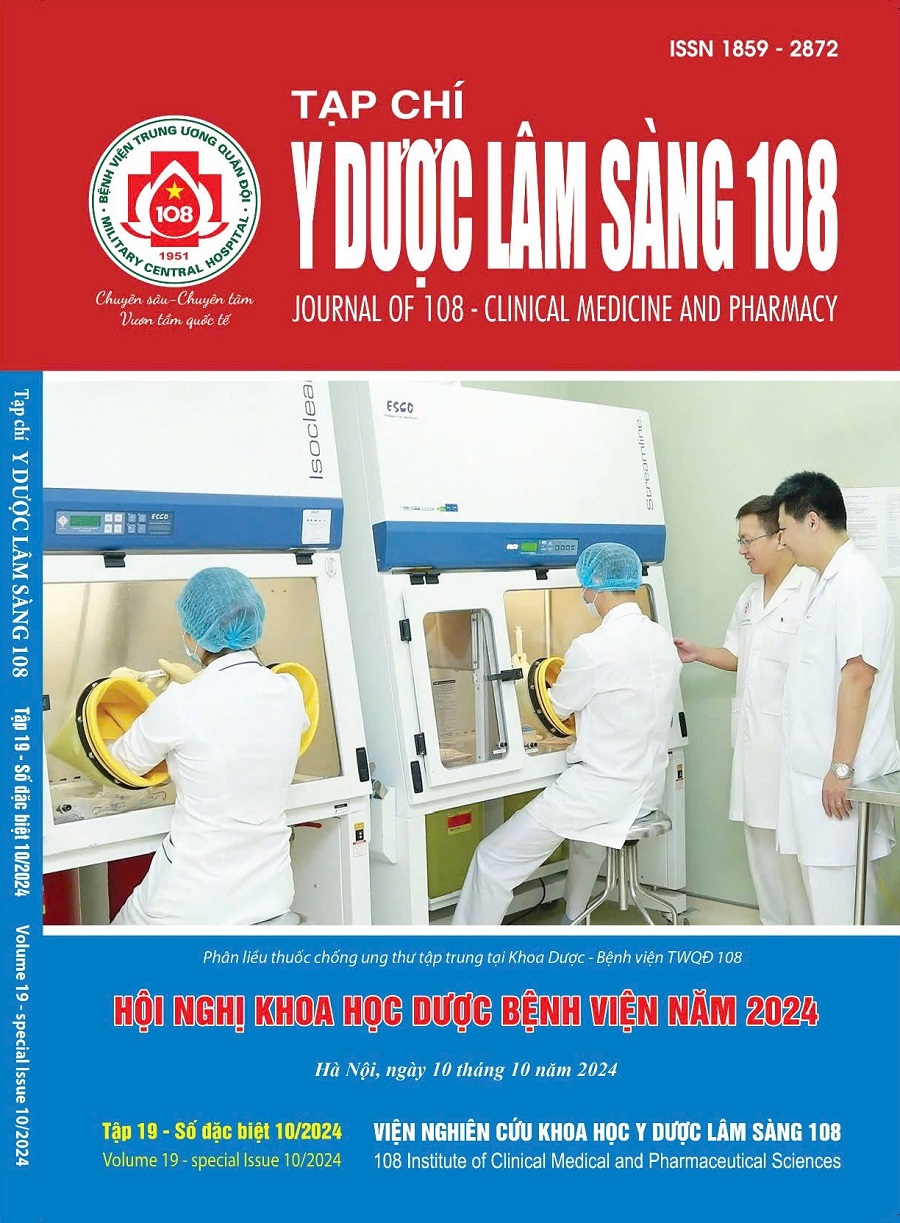Analysis of the current status of anticoagulant use in inpatients at Hanoi Heart Hospital
Main Article Content
Keywords
Abstract
Objective: The study aimed to analyze the characteristics of inpatients prescribed anticoagulants and the status of anticoagulant prescriptions at Hanoi Heart Hospital. Subject and method: A descriptive retrospective study, based on medical records of inpatients using anticoagulants at Hanoi Heart Hospital from 01/01/2023 to 28/02/2023. Result: A total of 326 patients using anticoagulants were included in the study. The mean age of study participants was 66.0 ± 13.3 years. The proportion of patients with ClCr < 30ml/min was 14%. The proportions of prescriptions for injectable and oral anticoagulants were 52.4% and 85.6% respectively. Enoxaparin were mainly prescribed for the treatment of acute coronary syndromes and the prevention of thrombosis after heart valve replacement/repair. Oral anticoagulants were used mostly to prevent strokes due to atrial fibrillation and heart valve replacement/repair. Conclusion: The use of anticoagulants should be monitored and the dose should be adjusted for each patient.
Article Details
References
2. Trần Thị Duyên (2022) Khảo sát thực trạng sử dụng thuốc chống đông tại Viện Tim mạch - Bệnh viện Trung ương Quân đội 108. Khoá luận tốt nghiệp Dược sĩ, Trường Đại học Dược Hà Nội.
3. Phùng Thị Hạnh (2020) Khảo sát thực trạng sử dụng thuốc trên bệnh nhân hội chứng mạch vành cấp điều trị nội trú tại Bệnh viện Tim Hà Nội. Khoá luận tốt nghiệp Dược sĩ, Trường Đại học Dược Hà Nội.
4. Hội Tim mạch học Việt Nam (2022) Khuyến cáo của Phân hội Nhịp tim Việt Nam về chẩn đoán và xử trí rung nhĩ. tr. 5-34.
5. Hội Tim mạch học Việt Nam (2016) Khuyến cáo về chẩn đoán và điều trị rung nhĩ.
6. Hội Tim mạch học Việt Nam (2016) Khuyến cáo về chẩn đoán, điều trị và dự phòng thuyên tắc huyết khối tĩnh mạch.
7. Nguyễn Thị Thuỷ (2021) Phân tích thực trạng sử dụng thuốc chống đông trên bệnh nhân nội trú tại Bệnh viện Hữu Nghị. Luận văn Thạc sĩ Dược học, Trường Đại học Dược Hà Nội.
8. Amsterdam EA, Wenger NK et al (2014) 2014 AHA/ACC guideline for the management of patients with non-ST-elevation acute coronary syndromes: executive summary: A report of the American College of Cardiology/American Heart Association Task Force on Practice Guidelines. Circulation 130(25): 2354-2394.
9. Konkle BA, Nkomo VT (2022) Antithrombotic therapy for mechanical heart valves. Uptodate.
10. Katzung BG et al (2017) Basic & Clinical Pharmacology, 14e. McGraw-Hill Education; 2017. Accessed October 01, 2024: 608-624.
11. Collet JP, Thiele H et al (2021) 2020 ESC Guidelines for the management of acute coronary syndromes in patients presenting without persistent ST-segment elevation. Eur Heart J 42(14): 1289-1367.
12. Hindricks G, Potpara T et al (2021) 2020 ESC Guidelines for the diagnosis and management of atrial fibrillation developed in collaboration with the European Association for Cardio-Thoracic Surgery (EACTS): The Task Force for the diagnosis and management of atrial fibrillation of the European Society of Cardiology (ESC) Developed with the special contribution of the European Heart Rhythm Association (EHRA) of the ESC. Eur Heart J 42(5): 373-498.
13. January CT, Wann LS et al (2019) 2019 AHA/ACC/HRS Focused Update of the 2014 AHA/ACC/HRS Guideline for the Management of Patients With Atrial Fibrillation: A Report of the American College of Cardiology/American Heart Association Task Force on Clinical Practice Guidelines and the Heart Rhythm Society. J Am Coll Cardiol 74(1): 104-132.
14. Brunton LL, Hilal-Dandan R, Knollmann BC et al (2011) Goodman & Gilman's: The Pharmacological Basis of Therapeutics, 13e. McGraw-Hill Education; 2017. Accessed October 01, 2024: 849-875.
15. Sanghai S, Wong C et al (2020) Rates of Potentially Inappropriate Dosing of Direct-Acting Oral Anticoagulants and Associations With Geriatric Conditions Among Older Patients With Atrial Fibrillation: The SAGE-AF Study. J Am Heart Assoc, 9(6): 014108.
16. Ting C, Rhoten M et al (2021) Evaluation of Direct Oral Anticoagulant Prescribing in Patients With Moderate to Severe Renal Impairment. Clin Appl Thromb Hemost 27: 1076029620987900.
17. Tiryaki F, Nutescu EA, Hennenfent JA, Karageanes AM, Koesterer LJ, Lambert BL, Schumock GT (2011) Anticoagulation therapy for hospitalized patients: Patterns of use, compliance with national guidelines, and performance on quality measures. Am J Health Syst Pharm 68(13): 1239-1244.
18. Shahmoradi L, Safdari R, Ahmadi H, Zahmatkeshan M (2021) Clinical decision support systems-based interventions to improve medication outcomes: A systematic literature review on features and effects. Med J Islam Repub Iran 35(27): 27-33.
 ISSN: 1859 - 2872
ISSN: 1859 - 2872
